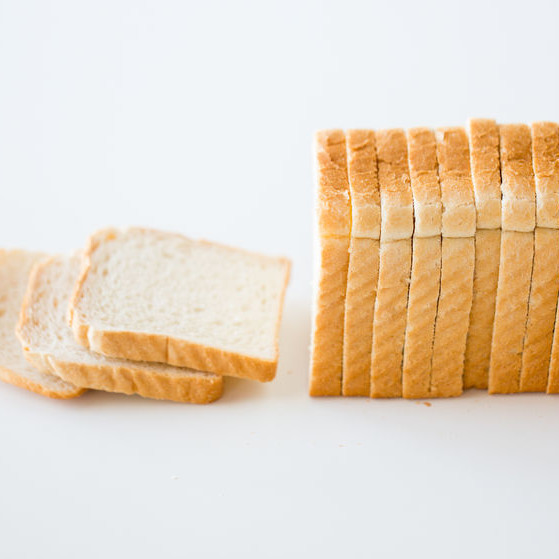
White Pan Bread
What is White Pan Bread?
White pan bread is a yeast-leavened baked product made from white or refined flour. It is proofed and baked in a constraining pan to maintain a consistent loaf shape and size throughout processing.
It is considered a lean bakery product and is the most prominent bread type worldwide. While other ingredients may be added to improve dough processing and finished product quality, the basic formula is:
- Patent flour
- Water
- Yeast
- Salt
How it is made
White pan bread can be produced with various dough systems, including:
- Straight dough
- Sponge and dough
- Liquid sponge: flour or water brew
- Chorleywood bread process (CBP)
- Sourdough
- Continuous dough mixing
White pan bread formulation
Providing sufficient time for fermentation prior to dough mixing is critical to producing optimum quality, texture and shelf-life of white pan bread. The following formula uses the sponge and dough system:
Sponge (70% flour pre-fermentation):
| Ingredient | Baker’s % (based on flour weight) |
| Patent or bread flour | 70.0 |
| Water (68°F/20°C) | 43.4 (62.0*) |
| Compressed yeast | 1.5** |
| Mineral yeast food (MYF) | 0.5 |
| Protease | 0.25 |
| Total | 115.65 |
*Hydration level, based on the weight of flour used in the sponge
**Yeast amount for an 8-hour sponge fermentation
Dough formulation (62% total hydration):
| Ingredient | Baker’s % (based on flour weight) |
| Patent (bread) flour | 30.0 |
| Water (38°F/3°C) | 18.6 |
| Compressed yeast | 2.5 |
| Salt | 2.0 |
| Sugar (refined, granulated sucrose) | 7.0 |
| Oil / shortening / butter | 3.5 |
| Nonfat dry milk (heat-treated) | 3.0 |
| Clean label dough conditioner mix* | 3.0 |
| Vital wheat gluten | 1.0 |
| Calcium propionate | 0.1 (1000 ppm) |
| Vinegar (100-grain) | 0.5 |
| Sponge | 115.65 |
| Total | 186.85 |
*Crumb softeners, dough strengtheners, enzymes, redox agents
Processing
- Sponge preparation
- Ingredients scaling.
- Sponge mixing at low speed until homogeneous mixture for 2–4 minutes.
- Sponge fermentation in bulk for 8 hours at room temperature, with 55–65% RH.
- Scaling of dough ingredients
- Dough mixing: Incorporate dough side ingredients and sponge at low speed. Then mix to full gluten development. Desired dough temperature out of mixer is 73–80°F (23–27°C).
- Floor time: Let dough rest for about 15 minutes.
- Makeup
- Dividing
- Rounding
- Intermediate proofing
- Sheeting and moulding
- Panning
- Final proofing: to full height, at 105–120°F (40–48°C) and RH of 80–85%. Proof times are typically 50–65 minutes.
- Baking: at 400–420°F (204–216°C) to an internal temperature of 204°F (95°C). This usually takes 18–22 minutes. The higher the oven temperature, the shorter the baking time.
- Cooling: to loaf internal temperature of 95–105°F (35–40°C) before packaging.
- Slicing
- Packaging
Commercial production
White pan bread is commercially produced with the straight (no time) dough system. There is a small portion of high-speed bakers, mainly in Europe and Asia, who still use the sponge and dough system to produce high-quality bread.
Application
Specifications for bread flour:
- Class of wheat: hard red spring (HRS), hard red winter (HRW), hard white (HW).
- Protein content: higher than 11.0%.1
- Ash content: 0.45–0.55%.1
- Moisture content: 13.0–14.0%
- Particle size: 120–180 µm (microns).
- Arabinoxylans content: 3.0–3.5%.1
- Damaged starch (DS): 6.0–12.0% (based on total starch in flour). DS becomes a very important parameter as food for yeast in low-sugar white pan breads, and dough systems that make use of long fermentation steps, like sponge and dough.1
- Falling Number (s): 200–300. Sufficient amylase activity to support sponge fermentation without added sugar. Flour with low enzymatic activity (Falling Number > 450 s) should be supplemented with diastatic malt.
Characteristics of white pan bread
| Internal | External |
|
|
References
- Finnie, S., and Atwell, W.A. “Composition of Commercial Flour.” Wheat Flour, 2nd edition, AACC International, Inc., 2016, pp. 31–48.

